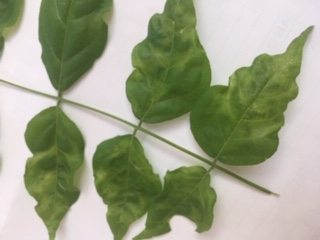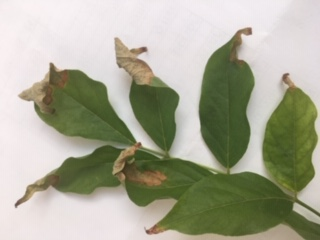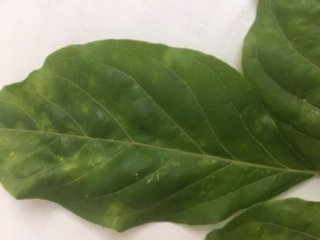Wisteria Vein Mosaic Virus
Advice from the Help Desk of the
UC Master Gardener Program of
Contra Costa County
Client's Question: This spring I planted 4 wisteria vines around our pergola and they've grown well but now two plants have bumpy leaves and one has brown curl at the end of a few leaves. I worked the soil well and added compost before planting. Any ideas? Thank you.


Help Desk Response: Thank you for contacting the UC Master Gardener Program Help Desk regarding your wisteria plants. Your photos are very helpful in showing the damage you mentioned. You mentioned that one plant has a few leaves with brown tips and curling, and 2 plants have “bumpy” leaves.
On those “bumpy” leaves, I see some yellow patches, and my research leads me to believe it is Wisteria Vein Mosaic virus. This virus affects a wide variety of horticultural and vegetable crops — roses, beans, tobacco, tomatoes, potatoes, cucumbers and peppers — This Mosaic is a viral disease found throughout the United States.
The virus is transmitted mechanically and by grafting. Cuttings or divisions from infected plants will carry the virus. It can be introduced into landscapes on new plants that were infected during their production. Other wisteria can become infected if it comes into contact with infected sap from a plant with the virus. For example, using the same tool for infected and non-infected plant without disinfecting in between use. Mosaic virus over winters on perennial plants and is spread by insects that feed on them. Aphids, leafhoppers, whiteflies and cucumber beetles are common garden pests that can transmit this disease. Soil, seed, starter pots and containers can be infected and pass the virus to the plant.
Once a plant becomes infected with the virus, it usually remains infected throughout its life.
Aside from discoloring foliage and distorted leaves, the virus does not seriously harm wisteria or significantly reduce the vigor of infected plants. There is no cure or treatment, and generally none is needed if the plant's cultural needs are met and it is otherwise healthy.
Here are a few precautions to take:
- Do NOT save seed from infected crops.
- The virus can be spread through human activity, tools and equipment. Frequently wash your hands and disinfect garden tools, stakes, ties, pots, greenhouse benches, etc.
- Avoid working in the garden during damp conditions (viruses are easily spread when plants are wet).
Here is a reference link from UC on the virus. Take a look at the photo attached to the article, it looks very similar to your photos. http://ipm.ucanr.edu/PMG/GARDEN/PLANTS/DISEASES/wisteriavirus.html
If you are interested, here is an article describing first report of Wisteria vein mosaic virus in Wisteria sinensis in the United States of America. https://www.plantmanagementnetwork.org/pub/php/brief/2008/wisteria/
Plant virus symptoms look similar to many nutrient deficiencies. The following conditions will also cause the brown tips and curling leaves that you see:
- Too much fertilizer/salt in the soil.
- Soil too wet and/or poor drainage.
- Other nutritional deficiencies.
You mentioned that you planted 4 plants and only one has brown tips. Take a look to see if that plant receives more sun than the others which might explain the brown tips.
Here is a reference on how to manage pests in wisteria. I recommend reading the articles under Environmental Disorders (on the right side of the screen), and there is also information on good cultural practices. http://ipm.ucanr.edu/PMG/GARDEN/PLANTS/wisteria.html
It is difficult to say whether the Mosaic virus is the cause of both the “bumpy” leaves and the brown tips and curling leaves or they are also caused by cultural practices (e.g. excess fertilization/salt, overwatering).
Since your plants are new and only planted in the spring, it is possible that the plants were already infected with the virus when you bought them. You might want to talk to the nursery and see if they would replace them.
I hope this information is helpful in managing your wisteria. I have a wisteria myself and it is such a joy to see the flowers in the spring. Please do not hesitate to contact us if you have further questions.
Help Desk of the UC Master Gardener Program of Contra Costa County (BY)
Note: UC Master Gardeners Program of Contra Costa's Help Desk is available almost year-round to answer your gardening questions. Except for a few holidays (e.g., last 2 weeks December), we're open every week, Monday through Thursday for walk-ins from 9:00 am to Noon at 2380 Bisso Lane, Concord, CA 94520. We can also be reached via telephone: (925) 608-6683, email: ccmg@ucanr.edu, or on the web at http://ccmg.ucanr.edu/Ask_Us/. MGCC Blogs can be found at http://ccmg.ucanr.edu/HortCoCo/ You can also subscribe to the Biog.
Attached Images:
